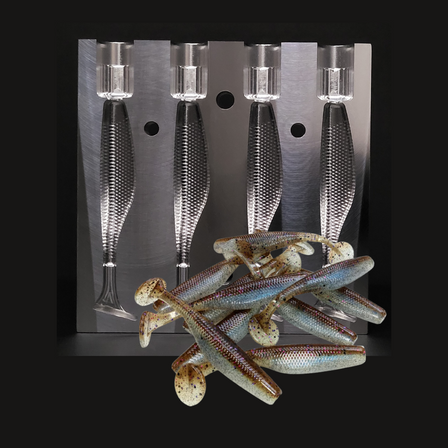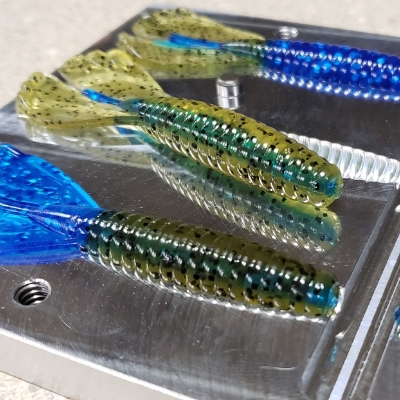Inshore Saltwater Fishing: Lure Mold Selection
By Angling Ai on 1st Nov 2022

Inshore Saltwater Fishing: Lure Mold Selection
Fishing inshore saltwater is an incredible experience for all anglers to enjoy. Coastal areas with mild climates allow fishermen to cast soft plastic fishing lures year-round. Targeting a vast array of gamefish is common with coastal inshore waters. Redfish, Speckled Trout, Flounder, Snook, and other species scour the banks and reefs searching for prey, and presenting the right lure is key to having a memorable day. Utilizing the right soft plastic fishing bait mold will definitely help increase your presence on the water.
Great Experiences Are Planned
Wonderful days rarely happen by just circumstance. “It must be nice” is an old saying that has always sparked my interest. Usually, anything that must be nice takes years of patience, practice, and work to occur. Your fishing trip success also depends on the same attributes. Having the proper equipment, keeping up with maintenance, and using fishing knowledge gained from experience or research will be a factor. When selecting molds to utilize, anglers who make their own soft plastics should consider several aspects.
- What species are going to be targeted?
- What area will it be in? (Bays, bayous, islands, etc.)
- What type of bottom will there be? (Sandy, muddy, shell, reefs, etc.)
- Will there be a strong or weak tidal flow?
- What is the clarity of the water?
- What type of conditions will exist? (Sunny, cloudy, windy, rainy, etc.)
- What time of year is it?
- What are the gamefish preying on primarily in the area?
Selecting an Effective Bait Mold
Once an angler knows the area that they will be fishing in, decisions can be made. Gathering or having prior knowledge of the location will guide the fisherman into what soft plastic lures should be considered. Inshore fish like to pursue their prey around structures such as grass-lined banks, reefs, and points that have moving water. Redfish often patrol the grass-lined banks of the marsh searching for bait fish, while speckled trout often chase shrimp over oyster reefs in bays or surround barrier islands stalking sandy bottoms.
When selecting which bait mold would be the most beneficial, understanding the targeted species, conditions, and style of fishing you wish to use is vital to your fishing trip's success.
Bait Molds for Redfish
Power fishing for redfish is a very common technique that allows anglers to cover large amounts of water and sight fish them as well. Swimbaits are very effective lures when targeting the bronze backs of the inshore. Redfish are opportunistic predators, although they will use their sight, feel, and smell senses to feed. Often they scour the bottoms of flats and tail around the banks of the marsh, allowing anglers to see their presence. Redfish love to attack, and swimbaits are the perfect bait to get their attention.
Angling Ai offers several swimbait molds to make soft plastic baits to entice them while stalking the banks. Open-pour versions of the four-inch swimbait have been known to draw attention; however, the 2.75 Little Hammer, 3.75 Hammer, and the new 3.8” RipRap swimbait molds have made quite the splash with getting Redfish to strike. Hammer designs offer a bigger tail and create more thump and wobble for the predator to feel its vibration. This creates an effect of a minnow trying to escape or adds a little vibration to murkier waters. RipRap swimbaits have a much tighter tail kick and allow anglers to present a bait that is much more subtle but still creates some vibration. When a yo-yo technique or rise-and-fall approach is used, the tail will subtly move and aggravate a less aggressive fish to react. When ‘making your baits-your way,’ color can be determined by the bottom or clarity of the water. Redfish seem to love both bright and gold colors as well as natural-looking baits.
Rip Rap pictured left, 3.75” Hammer Right
Bait Molds for Speckled Trout
Speckled Trout are also known for their prowess in and around inshore coastal areas. Although these fish can be found near marshy banks, at times they often prefer slightly deeper water. Bays and island shores are where they like to roam and do most of their feeding. Current that runs around structures such as reefs, sand bars, pilings, points, and mouths of bayous or canals attract the yellow-mouthed creatures. Primary prey for them is often minnows, sand eels, and of course, shrimp. Swimbaits for trout can be just as effective as they are for redfish, but the primary trout fishing technique often applies the use of a popping cork. Fishermen love to target trout under a cork. Double rigs will often be tied onto the bottom of their lines in hopes of catching two fish at a time. Swimbaits may be used in this fashion, but many anglers enjoy using curl tails and baits that can mimic a shrimp. Mold offerings from Angling Ai for curl tails include the five-inch single-tail grub and the four-inch ‘Cali’ grub.
5-inch Single Tail pictured left 4”-inch ‘Cali’ Grub Right
Angling Ai offers two mold designs that impersonate a shrimp in the water. The 3.6-inch and 4.1-inch Action Worm as well as the 4-inch Minna. The mold designs can be found in the Drop Shot Worm category on the website. The baits from the molds do not look shrimp-like in hand, but they do offer trout that appearance in the water.
3.6-inch Action Worm Left 4-inch Minna right
Techniques used with a popping cork will depend on conditions and how the fish are feeding. Popping the cork can be done quickly or in short bursts. Speckled Trout will sometimes prefer the cork not to be popped at all. In a smooth current, the bait just being floated over the reef or structure using the current to provide the action of the lure is more than enough. What is even better about inshore fishing is that every one of the baits created from these molds can catch multiple species. The techniques used can help you target certain fish, but at any time, another species can be lured into being on the hook.
No Matter The Catch, Angling Ai Can Help
Angling Ai offers plenty of molds that can be used in several different ways. Imagination and creativity allow bait makers to produce high-quality bait and increase their enjoyment on the water. Mold selection can be guided by your experience and knowledge. Personal preference and how you envision a lure in the water is a huge part of the fun in bait making. ‘Making your baits your way’ allows you to challenge yourself and invent ideas that will challenge the fish you target. Creating color schemes that no one else can find, using a blend of plastic to ensure you are getting the bait action you desire, and catching fish with soft plastics you produced with your knowledge. Well, “it must be nice,” get your high-quality soft plastic bait molds at Angling Ai, and ‘PUT THAT ON A HOOK.”



